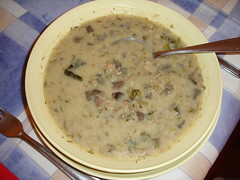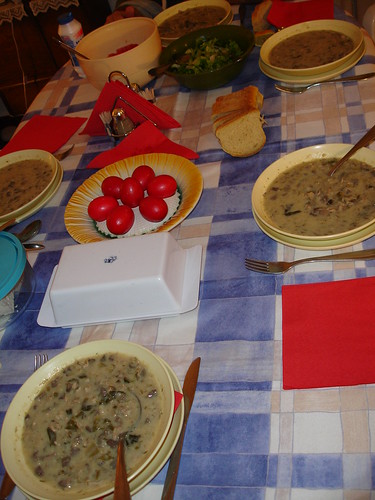Orthodox Greek Easter: 15th of April 2012 - Easter is one of the most important holiday in Greece

The Greek Orthodox Easter is a time for celebrations and festivities that surpass even the most lavish of Christmas revelry anywhere in the world. The Greek Orthodox Easter is calculated using a different calendar to the Catholic Church and the two can be up to three weeks apart. Greek families travel from all over the world to get together in their home villages in an incredible atmosphere with fireworks and feasting.

 On Good Friday, all the churches decorate the Epitaph with spring flowers, and cover it with sweet-smelling leaves and petals. It is moving to join the procession of mourners as they go round the parish with lighted candles to bless the area and the houses.Saturday at midnight, the Resurrection is celebrated.
On Good Friday, all the churches decorate the Epitaph with spring flowers, and cover it with sweet-smelling leaves and petals. It is moving to join the procession of mourners as they go round the parish with lighted candles to bless the area and the houses.Saturday at midnight, the Resurrection is celebrated. It is customary for everyone to take their candle home with them, doing their best not to let it go out on the way, bringing home the Resurrection light, which is a blessing for the rest of the year. Right after midnight, 'war' is declared when all the fireworks and bangers explode! It is customary, after the 40-day fast, to roast lambs and eat the red-dyed eggs that have been prepared for the Easter period. The Easter meal would not be complete without the Easter bread, which housewives usually bake on Maundy Thursday. It is decorated with a cross and has a red egg in the centre.
Like Christmas, which is related to pre-Christian winter festivals, Easter is connected in many ways with pagan rituals that accompanied the arrival of spring. It is possible that the name "Easter" stemmed from that of Eostre, an Anglo-Saxon goddess of springtime. Easter is also associated with the Jewish festival of Passover, or Pesach. The term "paschal", meaning "of Easter", is derived from the name of the Jewish festival, as are the names of Easter in some foreign languages. In Greek, Easter is called Pascha, meaning passover: It is the eternal Passover from death to life and from earth to heaven.
One of the most common Christian symbols, especially associated with Easter, is the lamb. It is often depicted with a banner that bears a cross, and it is known as the Agnus Dei, meaning "Lamb of God" in Latin. The origin of the symbol is related directly to the Jewish Passover. In ancient times the Jews sacrificed a lamb in the course of the festival. The early Christians, most of whom were Hebrews, associated the sacrifice of the lamb with Christ's sacrifice on the cross. They connected the joyous Passover festival, which commemorates the liberation of the Hebrews from their years of bondage in Egypt, with the liberation from death represented by the Resurrection. The popularity of lamb as an Easter food is undoubtedly related to its importance as a symbol. During the middle ages roast lamb became the traditional main course of the Pope's Easter dinner, and it is still customarily served on Easter Sunday in many European countries.
Greeks mainly color eggs red (scarlet) to signify the blood of Christ. They use hard-boiled eggs (painted red on Holy Thursday) which are baked into twisted sweet-bread loaves or distributed on Easter Sunday; people rap their eggs against their friends' eggs and the owner of the last uncracked egg is considered lucky. In Christianity, the egg is a symbol of Resurrection, representing the emergence of Christ from His tomb to everlasting life. Over the centuries the symbolic associations of the egg have been more or less forgotten, and modern Easter eggs are valued primarily for their colorful appearance. Eggs of chocolate or other kinds of candy are favorites of the season.
 The Midnight service is called the Resurrection Service and it's without a doubt the most important day on the calendar. At midnight all the lights are extinguished in the church and the priest comes from behind the doors on the altar carrying a candle. He walks to someone in the front row and lights their candle and these people who receive the light of the resurrection, the light is a symbol of the resurrection, pass the light from candle to candle and the light fills the church. Everybody leaves the church just before midnight, singing a song the words of which mean, Jesus Christ has risen from the dead. Through death conquering death.
The Midnight service is called the Resurrection Service and it's without a doubt the most important day on the calendar. At midnight all the lights are extinguished in the church and the priest comes from behind the doors on the altar carrying a candle. He walks to someone in the front row and lights their candle and these people who receive the light of the resurrection, the light is a symbol of the resurrection, pass the light from candle to candle and the light fills the church. Everybody leaves the church just before midnight, singing a song the words of which mean, Jesus Christ has risen from the dead. Through death conquering death. At midnight at the moment of the resurrection all the families have gone to church together, all standing sort of huddled in these little insular units and everybody kisses everybody and say, "Christos anesti?", "alithos anesti", Christ has risen, indeed He has risen. And it's a very touching moment. In the moment of conquering death it's, it has a certain meaning to kiss your family. People have been saying these prayers unchanged for hundreds and hundreds and hundreds of years. It's a custom to carry this candle back home, taking care the flame is not extinguished. At the house a cross is made with the flame above the entrance door to bless the house and its inhabitants by the light of Christ's resurrection.
In some areas of Greece, it is customary for young people to light a huge bonfire in the churchyard to burn Judas, the apostle who betrayed Jesus. On Easter Sunday, after the Easter Service at 12 midday, traditional entertainment with the participation of all people is organised. Fasting has ended (The Great Fast (Lent)--beginning on a Monday 7 weeks before Easter) and huge dishes of lamb are enjoyed. The Greeks have many traditions on this day, however the most important is gathering the family together and roasting a lamb, rotisserie-style, ('Arni Pashalino tis Souvlas': Easter Lamb on the Spit) in their front yards.
-----------------------------------------------------------------------
As for food during Easter, you can't have a proper Greek Easter celebrations without lamb, kokoretsi, magiritsa, and eggs

On Holy Thursday the custom is to color Easter eggs and bake Tsoureki (Easter Sweet Bread). Out of the kitchens a smell of vinegar fills the air since vinegar is necessary for the color to set on the eggs. Some of the colored eggs are used to decorate the Sweet Easter Bread. The others are placed in glass bowls or in baskets on the living room table, filling the house with the spirit of Easter. Another custom which housewives still observe is to refrain from lighting a fire or cooking on Good Friday. The meal, prepared the day before, is quite simple, usually consisting of lentils boiled in plain water, vinegar, and oregano, and served with olives, scallions, and halva, all considered fasting food.


Easter is the feast that, more than any other, makes the migrating Greeks return to their homeland to roast the lamb on the spit and to crack the red Easter eggs with their families.
















































